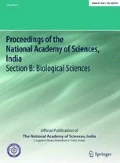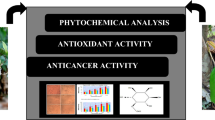Abstract
Clematis gouriana Roxb ex DC. (Ranunculaceae) is a large vine capable of climbing tall trees. In the Indian system of medicine ‘Ayurveda’, the plant is used to eliminate malarial fever and headaches. The root and stem paste are applied externally to treat psoriasis, itches, and skin allergies. Diverse biological properties of Clematis species are due to many secondary metabolites found in different parts of the plant. In the present study, C. gouriana leaf extract showed significant antioxidant, hepatoprotective and antiproliferative properties as compared to a standard compound, silymarin. The LD50 values of methanolic and aqueous leaf extracts were 500 and 700 mg/kg body weight, respectively. Both extracts significantly reduced CCl4-induced liver toxicity. The aqueous leaf extract decreased the levels of LPO and POX but increased the activities of SOD and CAT. Compared to ascorbic acid, which showed 97.28% inhibition against DPPH radical scavenging activity, the methanolic and aqueous extracts at 120 and 100 μg/ml concentrations showed 50.03 and 92.61% inhibition, respectively. Relative to the control drug doxorubicin (Adriamycin), the methanolic and aqueous extracts at any concentration (10–80 μg/ml) were unable to reduce the cytotoxicity of human colon cancer cell line HT29 or the human breast cancer cell line MCF7 when employing the sulforhodamine B assay.


Similar content being viewed by others
References
Newman DJ, Cragg GM, Snader KM (2003) Natural products as sources of new drugs over the period 1981–2002. J Nat Prod 66:1022–1037
Sharma AK, Sharma UK, Pandey AK (2017) Protective effect of Bauhinia variegata leaf extracts against oxidative damage, cell proliferation and bacterial growth. Proc Natl Acad Sci India 87:45–51
Kumar S, Pandey AK (2015) Free radicals: health implications and their mitigation by herbals. Br J Med Med Res 7:438–457
Kumar S, Dwivedi A, Kumar R, Pandey AK (2015) Preliminary evaluation of biological activities and phytochemical analysis of Syngonium podophyllum leaf. Natl Acad Sci Lett 38:143–146
Sharma AK, Kumar S, Chashoo G, Saxena AK, Pandey AK (2014) Cell cycle inhibitory activity of Piper longum against A549 cell line and its protective effect against metal-induced toxicity in rats. Ind J Biochem Biophys 51:358–364
Janbaz KH, Gilani AH (2000) Studies on preventive and curative effects of berberine on chemical-induced hepatotoxicity in rodents. Fitoterapia 71(1):25–33
Harsha VH, Hebbar SS, Shripathi V, Hegde GR (2003) Ethanomedicobotany of Uttara Kannada district in Karnataka, India—plants in treatment of skin diseases. J Ethnopharmacol 84:37–40
Manjunatha BK, Krishna V, Pullaiah T (2004) Flora of Davanagere District, Karnataka, India. Regency Publications, New Delhi
Saldanha CJ, Nicolson DJ (1984) Flora of Karnataka, India. Oxford and IBH Publishing Co, New Delhi, pp 90–92
Kumar S, Kumar R, Dwivedi A, Pandey AK (2014) In vitro antioxidant, antibacterial, and cytotoxic activity and in vivo effect of Syngonium podophyllum and Eichhornia crassipes leaf extracts on isoniazid induced oxidative stress and hepatic markers. Biomed Res Int 2014:459452
Kingsley SR (1939) The determination of serum total protein, albumin and globulin by the Biuret reaction. J Biol Chem 131:197–200
Reitman S, Frankel S (1957) A calorimetric method for the determination of serum glutamic oxaloacetic acid, glutamic pyruvic transaminase. Am J Clin Pathol 28:56–63
Bessey OA, Lowery DH, Brock MJ (1964) A method for the rapid determination of alkaline phosphatase with five cubic millimeters of serum. J Biol Chem 164:321–329
Galigher AE, Kayloff EN (1971) Essential of practical microtechnique. Lea and Febiger, Philadelphia, pp 77–81
Buege JA, Aust SD (1978) Microsomal lipid peroxidation. Methods Enzymol 52:302–310
Nicholos MA (1962) A spectrophotometric assay for iodide oxidation by thyroid peroxidase. Anal Biochem 4:311–345
Aebi H (1984) Catalyse in vitro. Methods Enzymol 105:121–126
Beauchamp C, Fridovich I (1971) Superoxide dismutase: improved assay and an assay applicable to acrylamide gel. Anal Biochem 10:276–287
Singh SDJ, Krishna V, Mankani KL, Manjunatha BK, Vidya SM, Manohara YN (2005) Wound healing activity of the leaf extracts and deoxyelephantopin isolated from Elephantopus scaber Linn. Indian J Pharmacol 37:238–242
Bagul MS, Ravishankara MN, Padh H, Rajani M (2003) Phytochemical evaluation and free radical scavenging properties of rhizome of Bergenia ciliata (Haw) Sternb. J Nat Rem 3:83–89
Nishimiki M, Appaji N, Yagi K (1972) The occurrence of superoxide anion in the reaction of reduced phenazine mehosulphate and molecular oxygen. Biochem Biophy Res Commmun 46:849–854
Zhu W, Fung PC (2000) The roles played by crucial free radicals like lipid free radicals, nitric oxide, and enzymes NOS and NADPH in CCl4-induced acute liver injury of mice. Free Radic Biol Med 29:870–880
Kaplowitz N, Aw TY, Simon FR, Stolz A (1986) Drug-induced hepatotoxicity. Ann Intern Med 104:826–839
Handa SS, Sharma A (1990) Hepatoprotective activity of andrographolide from Andrographis paniculata against carbon tetrachloride. Ind J Med Res 92:276–283
Mishra A, Kumar S, Pandey AK (2013) Scientific validation of the medicinal efficacy of Tinospora cordifolia. Sci World J 2013:222934
Kumar S, Pandey S, Pandey AK (2014) In vitro antibacterial, antioxidant, cytotoxic activities of Parthenium hysterophorus and characterization of extracts by LCMS analysis. Biomed Res Int 2014:495154
Kumar S, Pandey AK (2013) Chemistry and biological activities of flavonoids: an overview. Sci World J 2013:162750
Molander DW, Wroblewski F, La Due JS (1955) Transaminase compared with cholinesterase and alkaline phosphatase an index of hepatocellular integrity. Clin Res Proc 3:20–24
Kumar S, Pandey AK (2013) Chemistry and biological activities of flavonoids: an overview. Sci World J 2013:162750
Kumar S, Chashoo G, Saxena AK, Pandey AK (2013) Parthenium hysterophorus: a probable source of anticancer, antioxidant and anti-HIV agents. Biomed Res Int 2013:810734
Acknowledgements
The authors thank the University Grants Commission for a Major Research Project (UGC Letter No. 42-179/2013(SR)) for financial assistant to carry out the research work.
Author information
Authors and Affiliations
Corresponding authors
Ethics declarations
Conflict of interest
The authors declare no conflicts of interest to publish this manuscript.
Additional information
Significance statement Effective antioxidant, hepatoprotective and antiproliferative properties of the methanolic and aqueous leaf extracts of the ethnomedicinally important plant, Clematis gouriana were recorded, fortifying its uses in Ayurveda.
Rights and permissions
About this article
Cite this article
Naika, H.R., Bhavana, S., Lingaraju, K. et al. Antiproliferative, Antioxidant and Hepatoprotective Activities of Clematis gouriana Roxb. Extracts. Proc. Natl. Acad. Sci., India, Sect. B Biol. Sci. 89, 921–929 (2019). https://doi.org/10.1007/s40011-018-1008-7
Received:
Revised:
Accepted:
Published:
Issue Date:
DOI: https://doi.org/10.1007/s40011-018-1008-7




